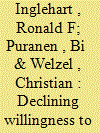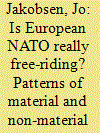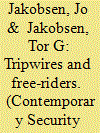| Srl | Item |
| 1 |
ID:
140076


|
|
|
|
|
| Summary/Abstract |
The Democratic Peace thesis suggests that the absence of war between major powers since 1945 is caused by the spread of democracy. The Capitalist Peace thesis emphasizes trade and the rise of knowledge economies as the forces driving peace. Complementing these interpretations, we present empirical evidence of a cultural change that is making peace more desirable to the publics of most societies around the world. Analyzing public opinion data covering 90% of the world’s population over three decades, we demonstrate that improving existential conditions elevate the life opportunities of growing population segments and lead them to become increasingly tolerant of diversity and place growing emphasis on self-realization. In recognition of life’s rising opportunities, people’s valuation of life changes profoundly: readiness to sacrifice one’s life gives way to an increasing insistence on living it, and living it the way one chooses. Hence, pro-choice values rise at the same time as willingness to sacrifice lives in war dwindles. Historical learning based on the specific experiences of given societies has also changed their publics’ willingness to fight in wars. This transformation of worldviews places interstate peace on an increasingly solid mass basis.
|
|
|
|
|
|
|
|
|
|
|
|
|
|
|
|
| 2 |
ID:
162502


|
|
|
|
|
| Summary/Abstract |
Does European NATO free-ride on America? This article uses a mixed-methods approach to explore developments after the Cold War. I investigate both “material” measures, such as military expenditure and troop numbers, and a “non-material” indicator that draws on survey data of the public’s willingness to fight for their country. Results and conclusions are not univocal. On the one hand, European NATO members have generally reduced their military spending (relative to GDP), abolished conscription and downsized their military forces. Their citizens’ self-reported willingness to fight has also been quite low after the Cold War, in particular in states that host US military bases. On the other hand, some of these developments can surely be explained by a decrease in threat perceptions in Europe. Trends changed markedly after Russia’s 2014 annexation of Crimea, which moved many allies – in particular new NATO member states – to increase their defence efforts.
|
|
|
|
|
|
|
|
|
|
|
|
|
|
|
|
| 3 |
ID:
166609


|
|
|
|
|
| Summary/Abstract |
This article investigates the relationship between U.S. overseas troops and the willingness of the citizens of host states to fight for their country. The study joins the long-running debate about burden-sharing and free-riding among U.S. allies. Unlike most previous empirical studies, we focus on non-material or intangible measures of the underlying concepts. Our dependent variable estimates the proportion of citizens expressing a willingness to fight for their country. Scores at the aggregate-national as well as the individual level are shaped by the presence of U.S. military forces, which act as a “tripwire” signaling credible security commitments. This increases opportunities of (non-material) free-riding. We present both bivariate and multivariate analyses covering the period 1981–2014 to test this supposition. Findings indicate that once U.S. troop levels reach a certain threshold (between 100 and 500 troops), citizens’ willingness to fight drops significantly. This likely reflects non-material free-riding.
|
|
|
|
|
|
|
|
|
|
|
|
|
|
|
|